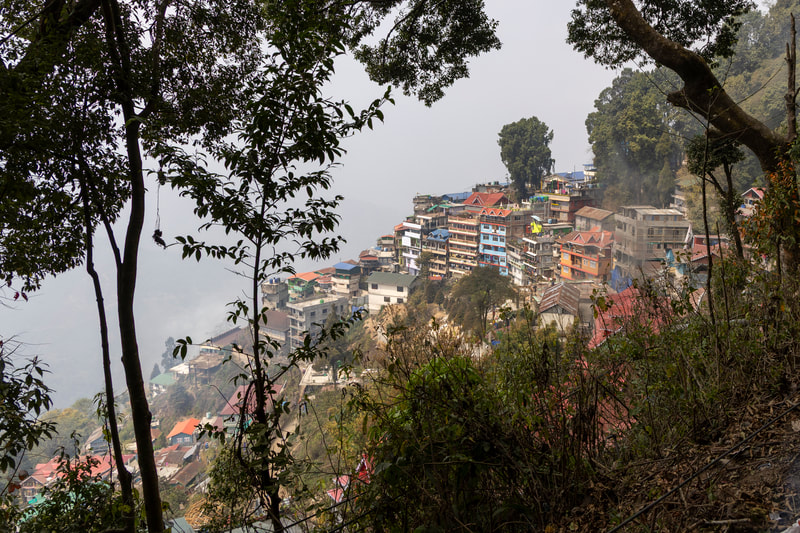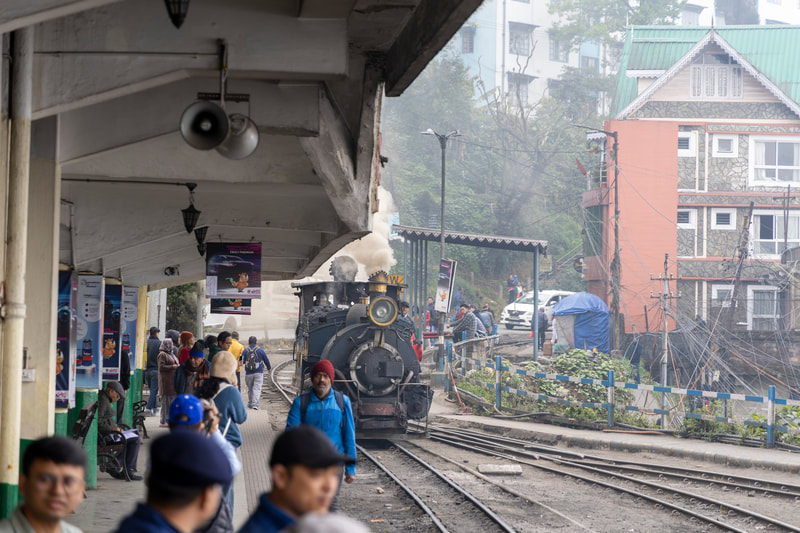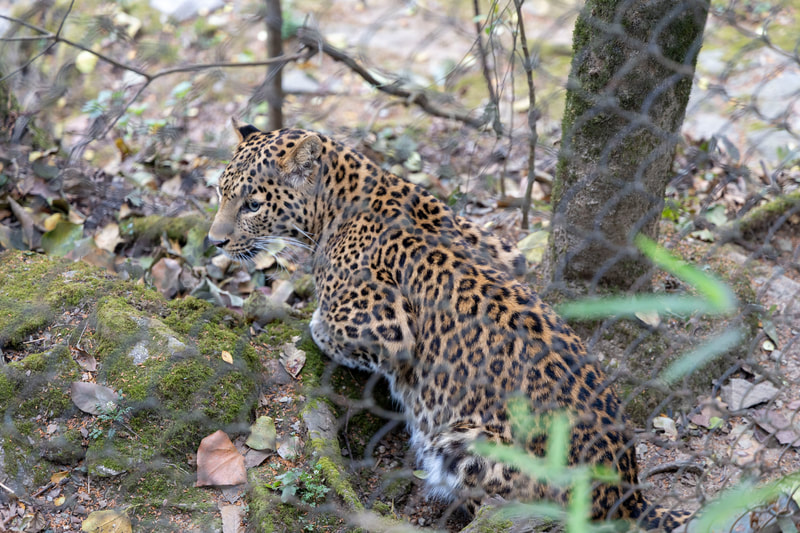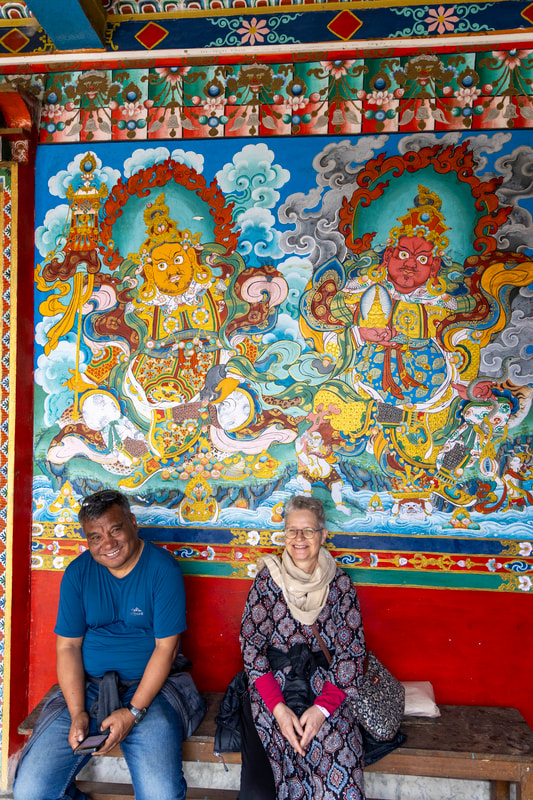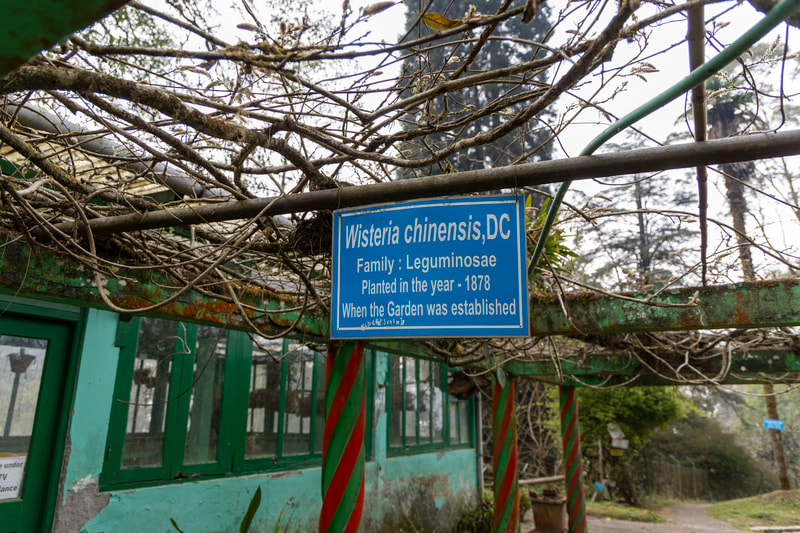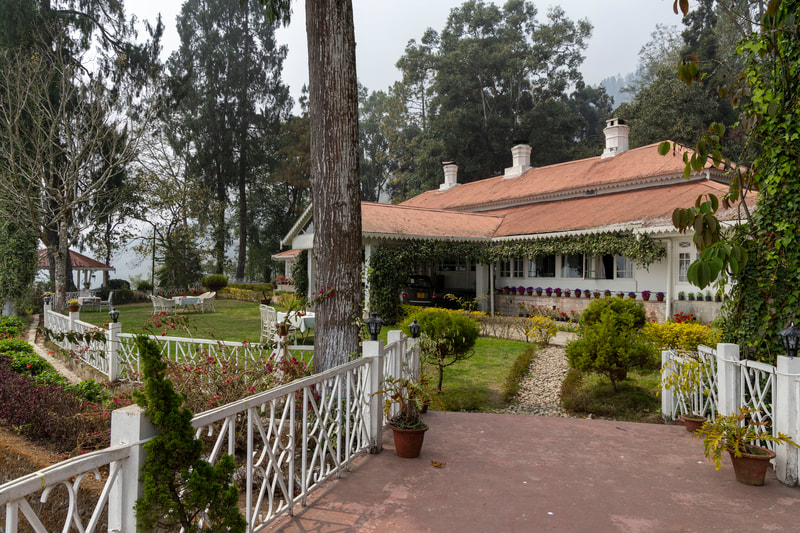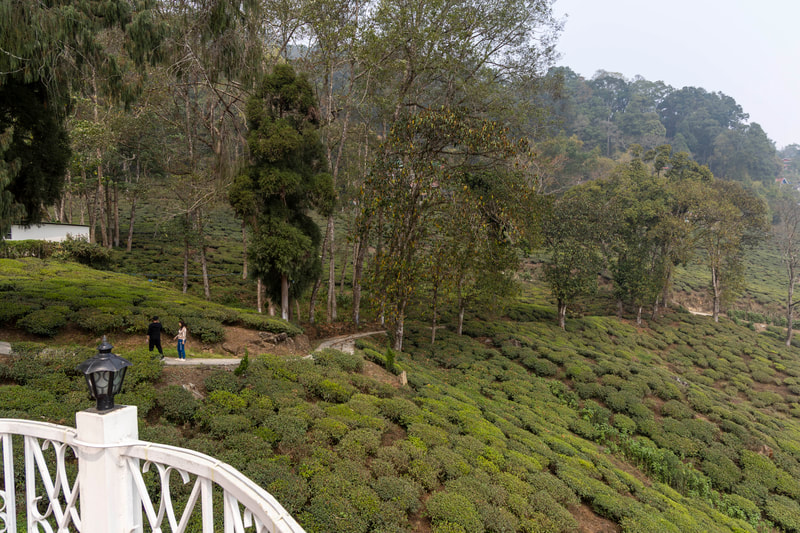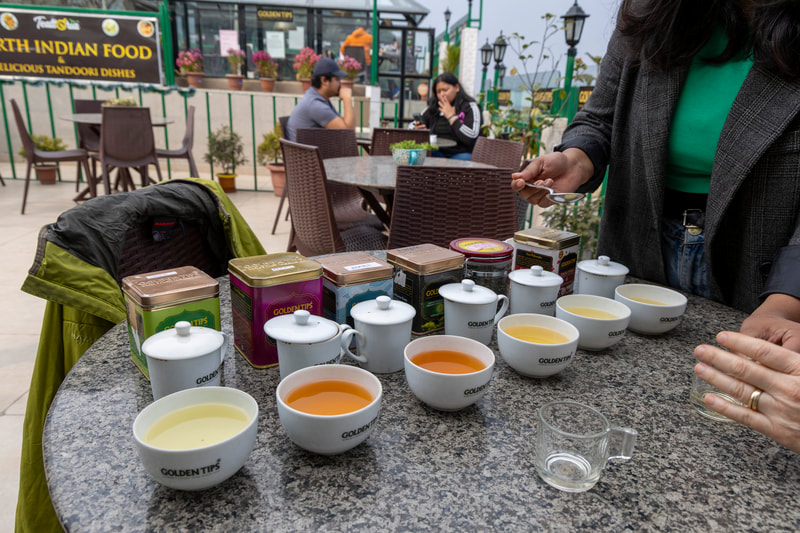|
Darjeeling ist in sehr steilen Berghängen gebaut worden, inmitten von Wäldern und heute natürlich Teeplantagen. Das Zentrum ist überschaubar, aber die Stadt breitet sich natürlich aus. Der grösste Teil der Bewohner*innen kommt ursprünglich aus Nepal und lebt seit Generationen hier. Auch Tibeter*innen gibt es viele. Von der Architektur her, finden wir eine spannende Mischung aus Kolonialstil und indischen "normalen" Häusern vor. Es gibt auch christliche Kirchen, Hindu-Tempel und buddhistische Kloster. Was in dieser Gegend speziell und sehr schön ist, sind die vielen blühenden Pflanzen, die vor jedem Haus stehen (nicht so sehr in der Innenstadt, aber überall sonst). Das ist offensichtlich eine Tradition hier. Die Gegend lebt v.a. vom Tourismus und in zweiter Linie vom Tee, wobei zweiteres leicht in der Krise steht: die Arbeiter*innen begehren wegen der Löhne auf, ein paar Plantagen mussten schon schliessen. Ebenfalls ist es fraglich, wie es mit dem Teepflücken weitergeht, ist auch unsicher. Die junge Generation hat ein besseres Bildungsniveau und möchte diesen Beruf nicht mehr ausüben. In den paar Tagen, in denen wir in der Stadt waren, haben wir mit einem Guide einen langen Spaziergang um den Berg gemacht, wo Darjeelings Zentrum steht. Wir haben ein tibetische Zentrum für Flüchtlinge besucht (The Tibetan Refugee Self-Help Centre, es existiert seit 1959), ein buddhistisches Kloster, Tee gekostet, den Dampfzug genommen, der Toy Train (= Spielzeugzug) heisst und 1879 bis 1881 von den Briten gebaut wurde, den botanischen Garten und den Zoo. Danach sind wir (mit einer Magenverstimmung) in eine Teeplantage umgesiedelt, wo wir noch drei entspannte Tage verbracht haben. Essen und Trinken: Tee ☺️: In der Teeplantage haben wir erfahren, wie der Tee gepflückt und produziert wird. Es gibt drei Qulitäten in Darjeeling: first flush, second flush und autumn flush. Die erste Ernte fällt deutlich geringer aus als die nächsten beiden. Sie ist sehr zart und wird zum Teil mit anderen (kleineren) Maschinen verarbeitet als die nächsten beiden Ernten. Ebenfalls ist mehr Handarbeit involviert. So erklärt sich der Preisunterschied; first flush ist natürlich teurer. Der Unterschied zwischen den Qualitäten ist frappant: first flush ist ganz hellgelb und feiner im Geschmack. Spätere Tees sind rötlich-braun und kräftiger; wir fanden den von der Plantage sogar etwas erdig. Es gibt fünf Schritte in der Produktion, die ich hier auf Englisch notiere: 1) Withering: Die Feuchtigkeit wird den Blättern entzogen. 2) Rolling: Die Blätter kommen in eine Maschine und werden dort gerollt (kleinere Maschinen für first flush). 3) Natural Fermenting: temperatur-kontrollierte Fermentierung. 4) Drying: Trocknung. 5) Sorting: Sortierung in 5 Qualitätsgraden; die ersten zwei werden als Blatttee verkauft, die nächsten beiden in Teebeutel verpackt und die letzte ist wie Staub und kann man nicht benützen. Beim Essen ist auffällig, dass hier viel mehr Fleisch gegessen wird als im Süden, meistens Huhn. Wir haben jeden Tag Huhn und Eier gegessen, manchmal auch anderes Fleisch. Es gibt viel tibetisches Essen, so haben wir mehrmals Momos bekommen und auch Nudelsuppen. In der Stadt gibt es auch ein schönes Kaffee mit Bäckerei und natürlich alles Mögliche an kleinen Restaurants, Imbissen und grösseren Hotels mit recht internationaler Küche. In der Teeplantage hatten wir Vollpension und die Küchenmannschaft hat uns mit abwechslungsreichen Speisen verwöhnt: mal kontintal, mal chinesisch und auch indisch; immer mit viel Liebe zubereitet und lecker. Darjeeling is built on very steep mountain slopes, surrounded by forests and today, of course, tea plantations. The centre is small, but the town spreads out. Most of the inhabitants are originally from Nepal and have lived here for generations. There are also many Tibetans. In terms of architecture, we find a mix of colonial style and Indian ‘normal’ houses. There are also Christian churches, Hindu temples and Buddhist monasteries. What is special and very beautiful in this area are the many flowering plants in front of every house (not so much in the city centre, but everywhere else). This is obviously a tradition here. The area lives primarily from tourism and secondarily from tea, although the latter is slightly in crisis: the workers are revolting over wages and a few plantations have already had to close. The future of tea picking is also uncertain. The younger generation has a better level of education and no longer wants to pursue this profession. In the few days we were in the city, we took a long walk with a guide around the mountain where Darjeeling's centre is located. We visited a Tibetan centre for refugees (The Tibetan Refugee Self-Help Centre, which exists since 1959), a Buddhist monastery, we have tasted tea, took the steam train, which is called the Toy Train and was built by the British between 1879 and 1881, the botanical garden and the zoo. We then moved (with an upset stomach) to a tea plantation, where we spent another three relaxing days. Eating and drinking: Tea ☺️: At the tea plantation, we learnt how the tea is picked and produced. There are three qualities in Darjeeling: first flush, second flush and autumn flush. The first harvest is significantly smaller than the next two. It is very delicate and partly processed with different (smaller) machines than the next two harvests. More manual labour is also involved. This explains the price difference; first flush is naturally more expensive. The difference between the qualities is striking: first flush is very light yellow in colour and finer in flavour. Later teas are reddish-brown and stronger; we even found the one from the plantation a little earthy. There are five steps in the production process: 1) Withering: the moisture is extracted from the leaves. 2) Rolling: The leaves are placed in a machine and rolled (smaller machines for first flush). 3) Natural fermenting: temperature-controlled fermentation. 4) Drying. 5) Sorting: Sorting into 5 quality grades; the first two are sold as leaf tea, the next two are packed in tea bags and the last one is like dust which cannot be used. When it comes to food, it is noticeable that much more meat is eaten here than in the south, mostly chicken. We ate chicken and eggs every day, sometimes other meat too. There is a lot of Tibetan food, so we had momos several times and also noodle soups. In the town there is also a nice coffee shop with a bakery and of course all sorts of small restaurants, snack bars and larger hotels with quite international cuisine. We had full board at the tea plantation and the kitchen team spoilt us with a variety of dishes: sometimes continental, sometimes Chinese and also Indian; always prepared with a lot of love and delicious. Darjeeling a été construite sur des versants de montagne très escarpés, au milieu de forêts et aujourd'hui, bien sûr, de plantations de thé. Le centre est à taille humaine, mais la ville s'étend. La majeure partie des habitants est originaire du Népal et vit ici depuis des générations. La population tibétaine est également impotante. Du point de vue de l'architecture, nous trouvons un mélange de style colonial et de maisons indiennes « normales ». Il y a aussi des églises chrétiennes, des temples hindous et des monastères bouddhistes. Ce qui est spécial et très beau dans cette région sont les nombreuses plantes à fleurs qui se trouvent devant chaque maison (pas tellement dans le centre-ville, mais partout ailleurs). C'est évidemment une tradition ici. La région vit principalement du tourisme et, en second lieu, du thé, bien que ce dernier soit légèrement en crise : les ouvrières se révoltent à cause des salaires, quelques plantations ont déjà dû fermer. L'avenir de la cueillette du thé est également incertain. La jeune génération a un meilleur niveau d'éducation et ne souhaite plus exercer ce métier. Pendant les quelques jours où nous étions en ville, nous avons fait une longue promenade avec un guide autour de la montagne où se trouve le centre de Darjeeling. Nous avons visité un centre tibétain pour les réfugiés (The Tibetan Refugee Self-Help Centre, qui existe depuis 1959), un monastère bouddhiste, dégusté du thé, pris le train à vapeur appelé Toy Train (= train jouet) construit par les Britanniques entre 1879 et 1881, le jardin botanique et le zoo. Ensuite, nous nous sommes déplacés (avec une indigestion) dans une plantation de thé où nous avons encore passé trois jours de détente. Manger et boire : Thé ☺️ : dans la plantation de thé, nous avons appris comment le thé est cueilli et produit. Il existe trois qualités de thé à Darjeeling : first flush, second flush et autumn flush. La première récolte est nettement moins voumineuse que les deux suivantes. Elle est très tendre et traitée en partie avec d'autres machines (plus petites) que les deux récoltes suivantes. Le travail manuel est également plus important. C'est ce qui explique la différence de prix ; le first flush est naturellement plus cher. La différence entre les qualités est frappante : le first flush est d'un jaune très clair et d'un goût plus fin. Les thés tardifs sont d'un brun rougeâtre et plus forts ; nous avons même trouvé celui de la plantation un peu terreux. Il y a cinq étapes dans la production, que je note ici en anglais : 1) Withering : l'humidité est retirée des feuilles. 2) Rolling : les feuilles sont placées dans une machine où elles sont roulées (machines plus petites pour le first flush). 3) Natural Fermenting : fermentation à température contrôlée. 4) Drying : séchage. 5) Sorting : triage en 5 degrés de qualité ; les deux premiers sont vendus comme thé en feuilles, les deux suivants sont emballés dans des sachets de thé et le dernier est comme de la poussière et ne peut pas être utilisé. En ce qui concerne la nourriture, il est frappant que l'on mange beaucoup plus de viande ici que dans le sud, le plus souvent du poulet. Nous avons mangé du poulet et des œufs tous les jours, parfois aussi d'autres viandes. Il y a beaucoup de nourriture tibétaine, nous avons donc eu plusieurs fois des momos et aussi des soupes de nouilles. En ville, il y a aussi un beau café avec une boulangerie et bien sûr toutes sortes de petits restaurants, de snacks et de grands hôtels avec une cuisine assez internationale. Dans la plantation de thé, nous avions la pension complète et l'équipe de cuisine nous a gâtés avec des plats variés : parfois continentaux, parfois chinois et aussi indiens ; toujours préparés avec beaucoup d'amour et délicieux.
0 Comments
Leave a Reply. |
About usWe are a couple in the mid-fifties and are going to live for two years in Hyderabad, India. Time in Hyderabad
Archives
May 2025
Categories |
